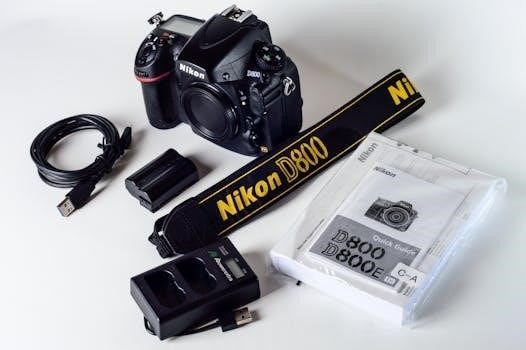
Nikon EM Instruction Manual⁚ A Comprehensive Guide
Welcome to your comprehensive guide to the Nikon EM, a camera designed for carefree photography. This manual will provide you with helpful information about the camera’s settings, features, and specifications. We’ll cover everything from loading film to troubleshooting common issues, with a focus on service and repair.
The Nikon EM, introduced in 1979, represents Nikon’s endeavor to make SLR photography more accessible. Marketed as a camera for “carefree photography,” the EM aimed to simplify the shooting experience for novice users. It distinguishes itself with its aperture-priority automatic exposure mode, allowing photographers to focus on composition while the camera handles the exposure settings.

This instruction manual serves as your comprehensive guide to understanding and utilizing the Nikon EM effectively. Whether you’re a seasoned photographer or new to the world of film SLRs, this guide will provide valuable insights into the camera’s features and functions.
Inside, you’ll find detailed instructions on various aspects of the Nikon EM, including loading film, setting the aperture, understanding the light meter, and using flash. We’ll also explore lens compatibility, common troubleshooting issues, and essential maintenance tips to keep your camera in optimal condition.
This guide is your key to unlocking the full potential of your Nikon EM, enabling you to capture stunning photographs with ease and confidence. It’s designed to be user-friendly and informative, ensuring you get the most out of your camera. Get ready to explore the world of film photography with your Nikon EM!
Key Features and Specifications
The Nikon EM boasts several key features that made it a popular choice among photographers. Its aperture-priority automatic exposure mode simplifies the shooting process, allowing users to concentrate on composition. The camera also offers a manual mode at 1/90th of a second and a Bulb (B) setting for long exposures, providing some manual control.
The EM is compatible with Nikon Series E lenses and AI-type Nikkor lenses, offering a wide range of options for different photographic needs. It also features a built-in light meter to assist with accurate exposure settings in automatic mode. The camera is designed to be used with the exclusive winder MD-E and flash unit SB-E, expanding its capabilities.
Here’s a summary of the key specifications⁚
- Type⁚ 35mm SLR camera
- Exposure Mode⁚ Aperture-priority automatic, Manual (1/90 sec), Bulb
- Lens Mount⁚ Nikon AI
- Shutter Speed Range⁚ Bulb, 1/90, Automatic (stepless)
- Metering⁚ Center-weighted
- ISO Range⁚ 25-3200
- Flash Sync⁚ 1/90 sec
- Power⁚ Two 1.5V silver-oxide batteries (SR44) or one 3V lithium battery (CR1/3N)
These features and specifications combine to make the Nikon EM a versatile and user-friendly film camera, suitable for both beginners and experienced photographers alike. It’s a great tool for exploring the art of photography.

Loading Film into the Nikon EM
Loading film into the Nikon EM is a straightforward process, but it’s essential to follow the steps carefully to ensure proper film advance and prevent light leaks. First, make sure the camera is switched off to avoid accidental exposures. Locate the film rewind knob on the left side of the camera and pull it upwards to open the camera back. This will release the latch and allow you to swing the back open.
Next, insert a fresh roll of film into the film chamber on the left side of the camera. Push the film canister down to ensure it is securely seated. Pull the film leader across the camera body and insert the tip into one of the slots on the take-up spool on the right side. Advance the film using the film advance lever, typically located on the top right of the camera. Ensure the film sprockets engage with the perforations on the film.
Close the camera back and continue to advance the film using the film advance lever until the frame counter displays “1.” This will ensure that any fogged or exposed film from loading is past. Set the ISO dial to match the ISO of the film you loaded. The camera is now ready to take pictures. Remember to rewind the film completely before opening the camera back after shooting all exposures.
Setting the Shutter Speed and Aperture
While the Nikon EM primarily operates in aperture-priority automatic mode, understanding how to influence shutter speed and aperture is crucial for creative control. In automatic mode, the camera selects the shutter speed based on the aperture you choose and the light it measures. To set the aperture, locate the aperture ring on the lens. Rotating this ring allows you to select your desired f-stop, which affects both the depth of field and the amount of light entering the camera.
The Nikon EM also offers a manual mode, accessible via the shutter operation mode selector. Setting it to “M90” fixes the shutter speed at 1/90th of a second, allowing manual aperture adjustment for specific situations. This can be useful for ensuring a minimum shutter speed in low light or for using flash, which often syncs at 1/60th or 1/90th of a second. In manual mode, the light meter will still function, providing guidance on proper exposure.
To achieve desired effects, remember that wider apertures (smaller f-numbers) create shallow depth of field, ideal for portraits, while narrower apertures (larger f-numbers) increase depth of field, suitable for landscapes. In automatic mode, observe how the camera responds to your aperture choice and adjust accordingly for optimal results. The EM prioritizes ease of use, but understanding these settings unlocks creative possibilities.
Using the Light Meter
The Nikon EM features a built-in light meter designed to assist in achieving proper exposure. This is particularly helpful since the camera predominantly operates in aperture-priority automatic mode. To activate the light meter, gently press the shutter release button halfway. Inside the viewfinder, you’ll observe a needle moving along a scale. This needle indicates the shutter speed the camera will select based on the chosen aperture and the amount of light entering the lens.
Ideally, you want the needle to be positioned within the acceptable range on the scale. If the needle is at the top, it suggests overexposure, indicating too much light. Conversely, if it’s at the bottom, underexposure is likely, meaning insufficient light. To correct overexposure, select a smaller aperture (higher f-number) or find a less brightly lit scene. For underexposure, choose a wider aperture (lower f-number) or seek a brighter environment.
Even in manual mode (M90), the light meter remains active, providing a reference point for your aperture selection. Use it as a guide to understand how your chosen aperture affects the potential exposure. Practice interpreting the light meter readings in various lighting conditions to develop a feel for exposure and achieve well-balanced photographs. Remember, the meter is a tool, and artistic interpretation may sometimes call for deviating from its suggestions.
Understanding the Shutter Operation Mode Selector
The Nikon EM’s shutter operation mode selector is a key control for determining how the camera functions. This dial, typically located near the shutter release button, offers a few distinct settings. The primary setting is “AUTO,” signifying aperture-priority automatic mode. In this mode, you select the desired aperture, and the camera automatically chooses the appropriate shutter speed for correct exposure, based on the light meter’s readings.
Another important setting is “M90.” This represents a manual mode, fixing the shutter speed at 1/90th of a second. This setting is useful when you want to control the shutter speed directly, especially in situations where the automatic mode might not produce the desired effect, or when the battery is depleted, as M90 is a mechanical speed.
The “B” setting stands for Bulb mode. In this mode, the shutter remains open for as long as the shutter release button is pressed. This is used for long exposures, typically in low-light conditions or when capturing motion blur. Remember to use a tripod to avoid camera shake during Bulb exposures.
Understanding these settings allows you to adapt to different shooting scenarios and exercise creative control over your photographs. The AUTO mode simplifies everyday shooting, while M90 and B provide manual options for specific needs.
Lens Compatibility and Mounting
The Nikon EM offers compatibility with a range of lenses, primarily those adhering to the Nikon F mount. This includes Nikon Series E lenses, Al-type Nikkor lenses, and AI-S lenses. These lenses provide a wide variety of focal lengths and apertures, expanding the creative possibilities with your EM. While the EM can use these lenses, it’s important to note that it functions primarily in aperture-priority mode, so manual aperture control on the lens is essential.

To mount a lens, first ensure that both the camera body and the rear lens cap are clean and free from dust. Align the mounting index (usually a dot or line) on the lens with the corresponding index on the camera body. Gently insert the lens into the mount and rotate it clockwise until it clicks into place. Ensure the lens is securely attached before use.
To remove a lens, locate the lens release button on the camera body, typically near the lens mount. Press and hold this button while simultaneously rotating the lens counter-clockwise until it disengages from the mount. Carefully remove the lens, and immediately attach the rear lens cap to protect the lens element.
Be cautious when changing lenses to prevent dust or debris from entering the camera body. Avoid changing lenses in dusty or windy environments. With proper care and compatible lenses, the Nikon EM can be a versatile tool for various photographic styles.
Using Flash with the Nikon EM
The Nikon EM is compatible with various flash units, enhancing its versatility in low-light conditions. For optimal performance, consider using the Nikon SB-E flash, specifically designed for the EM. However, other Nikon flashes and compatible third-party options can also be utilized.
To use a flash, first ensure the flash unit is properly mounted onto the camera’s hot shoe. Secure the flash by tightening the locking mechanism, if available. Turn on the flash unit and allow it to charge fully. The ready light on the flash will indicate when it’s prepared to fire. Set the camera’s shutter operation mode selector to the appropriate flash setting, usually indicated by a flash symbol or “M90” (mechanical speed of 1/90 sec).
The M90 setting synchronizes the camera’s shutter with the flash, ensuring proper exposure. The aperture should be set based on the flash’s guide number and the distance to the subject. Refer to the flash unit’s manual for specific guidance on aperture settings. When using automatic flash modes, the flash sensor measures the light reflected from the subject and adjusts the flash output accordingly.
Experiment with different flash techniques, such as direct flash, bounce flash, and off-camera flash, to achieve various lighting effects. Remember to consider the flash range and adjust the aperture or distance to the subject as needed. With proper use, flash photography can significantly expand the EM’s capabilities.
Troubleshooting Common Issues
Like any vintage camera, the Nikon EM can encounter certain issues. Addressing these problems promptly can extend the camera’s lifespan and ensure optimal performance. One common issue is a malfunctioning light meter. If the meter is inaccurate or unresponsive, first check the battery. A weak or dead battery can cause erratic meter readings. Replace the battery with a fresh one and retest the meter.
Another frequent problem is film advance failure. If the film does not advance properly, ensure the film is loaded correctly, and the rewind knob is turning as you advance. Clean the film transport mechanism if needed. Shutter problems can also arise, such as a sticky or unresponsive shutter. Try setting the shutter operation mode selector to “M90” (mechanical speed of 1/90 sec) to bypass the electronic components.
Lens mounting issues can also occur. Ensure the lens is properly aligned with the camera body and securely locked into place. Clean the lens contacts and camera mount if necessary. If the camera back is difficult to open, make sure the film rewind knob is fully pulled out. For persistent issues, consult a qualified camera repair technician.
Remember to always handle the camera with care and avoid exposing it to extreme temperatures or humidity. Regular maintenance and proper storage can prevent many common problems.
Maintenance and Care
Proper maintenance and care are crucial for preserving the longevity and optimal performance of your Nikon EM. Regular cleaning is essential to remove dust, dirt, and fingerprints from the camera body, lens, and viewfinder. Use a soft, lint-free cloth to gently wipe the exterior surfaces. For stubborn smudges, dampen the cloth slightly with a lens cleaning solution.
The lens elements should be cleaned with a dedicated lens cleaning solution and lens tissue. Avoid using excessive pressure or harsh chemicals that could damage the lens coatings; Periodically check the light seals around the camera back and replace them if they become brittle or deteriorated. Light leaks can compromise the quality of your photographs.
When storing your Nikon EM, keep it in a cool, dry place away from direct sunlight and extreme temperatures. Remove the battery to prevent corrosion if the camera will not be used for an extended period. Consider storing the camera in a padded case or bag to protect it from physical damage.
If you notice any unusual noises, stiffness, or other signs of malfunction, seek professional servicing. A qualified camera technician can diagnose and repair any issues before they escalate into more significant problems. With proper care, your Nikon EM can continue to provide years of reliable service and enjoyment.
